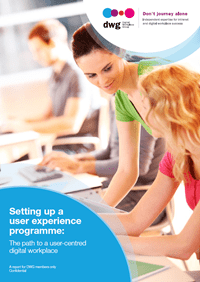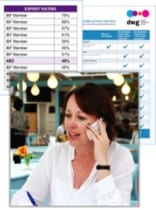5 steps toward setting up a digital workplace user experience programme

In a new report for DWG members, Setting up a user experience programme: The path to a user-centred digital workplace, user experience expert and DWG benchmarker Andrea M Lewis makes the case for user experience (UX) and sets out the steps towards establishing a programme for the intranet and wider digital workplace.
The report delves into solutions that practitioners are seeking as they set out to improve the employee experience of the internal, digital work environments within their organizations. In doing so, it recognizes that creating and implementing a UX programme tailored to an organization, and the specific needs of that organization’s users, requires backing and commitment from the entire organization.
Drawing on DWG benchmarking experience, as well as in-depth case studies from Adobe, Mayo Clinic and UniCredit, the report sets out practical steps towards establishing and progressing such a programme, including:
1. Be clear on why user experience matters
Although the benefits of UX are well understood in a marketing context, they frequently need to be spelled out in relation to internal digital tools. Such benefits may include:
- easier roll-outs of new software
- cost savings resulting from successful digitization
- improved organizational loyalty among employees
- enhanced collaboration inside the organization
- a sense of ownership and belonging for users
- increased engagement and productivity.
The hidden costs of ignoring UX also need to be understood, such as impacts on employee productivity and happiness due to cognitive load and cognitive friction, which can be caused by poor experiences.
2. Involve the right people from the start
Who is responsible for user experience in your organization? The simple answer is: everyone. Ensuring good user experience is a collaborative effort. No one person or small group can be entirely responsible for this. A common belief is that user experience is the sole responsibility of a specific team of designers, researchers or product owners. However, without input and support from the entire organization, it is difficult to implement user experience and turn those insights into actual practice.
This means that, as well as establishing a multidisciplinary team to help drive the programme, involvement of both users and stakeholders should be considered and planned early on, with a range of methods available to the practitioner, from interviews with senior stakeholders through to focus groups and questionnaires for users. In practice, establishing the team may involve a gradual upskilling of existing resources, with initial input from third-party consultants, as well as identifying and recruiting new skills such as user research, interaction design and information architecture.
3. Make the business case
Building on the first step, getting a UX programme off the ground will involve demonstrating why UX matters in a convincing business case. This needs to:
- articulate how business goals can benefit from improving the user experience
- demonstrate how concrete support in terms of resources and people’s time will impact the effectiveness of the overall organization in executing these goals
- include a plan that is incremental, collaborative and inclusive
- describe how knowledge and expertise can benefit the wider organization.
At the outset, identify the strategy that is currently in place and how this could be improved, based on the relevant goals of your organization. Next, explore how these goals translate to the benefits or outcomes you have identified in your UX programme.
Gaining budget for UX work can be tough. Think in terms of progressive requests, perhaps requesting a smaller budget for a specific project. Once there is some proof of success and method, it is more likely you will be able to gain support for larger programmes that will produce real digital transformation. Producing a cost model can help stakeholders understand how much the ongoing programme might cost.
4. Plan and implement a user research strategy
Once an internal system or journey that requires improvement has been identified, you will need to develop a plan that covers the methodology you intend to use, any resources required, who you will be researching with, and the logistics around when and where. This plan may be quite detailed; however, in order to engage time-poor stakeholders, there should also be a version that fits onto around one page, which is quick, clear and easy to understand.
Once you have clearly outlined your user research plans and begun the recruitment process for your proposed participants, it is now time to conduct some research. This could include a number of different approaches, such as usability testing, interviews and questionnaires. Usability testing sessions will involve prepping the participants to ensure they are comfortable and suitably informed, deciding on the technology and surroundings, encouraging a flexible discussion, gathering and analysing findings. It is also critical to think about how to communicate the findings and translate them into actionable results.
5. Measure success
User experience is successful when it has visible and quantifiable impact. Measuring success can take on a systematic approach, where the goal is to measure performance over a period of time. Is there an internal best standard? Is there an internal benchmark for good employee experience? Clear and specific measurements of “before and after” change can really help to gauge success; for example, you might measure how long it takes a user to complete a task before versus after a UX intervention has been made. This also allows for incremental improvements as you can measure the overall effect of one change compared to others.
Other systematic measures for UX improvements include:
- number of attempts to complete a specific task
- rate of error (or wrong-turns or backtracking) in a journey
- rate of success in achieving a task or completing a journey
- engagement with content, such as clicks, comments and “likes”.
In addition, there is DWG’s approach to benchmarking, which allows DWG members to compare their own intranet service or digital workplace solutions against industry best practice.
UX metrics will not only help you to measure what your programme has achieved, they will also measure the process that created the design. To be truly successful, these metrics and processes need to be reinforced by the desire of senior management to improve processes and deliver a great user experience.
Related research and resources
Setting Up a User Experience Programme
Arrange a call
to learn more
Categorised in: Digital workplace, Research reports
 Download executive summary»
Download executive summary»
